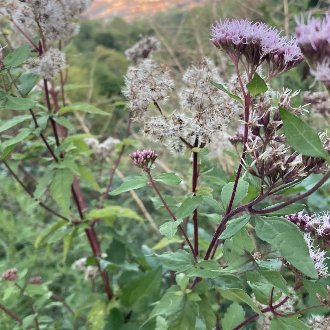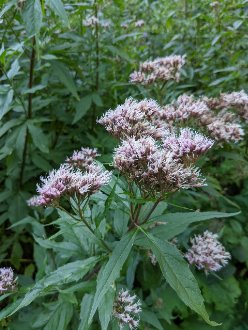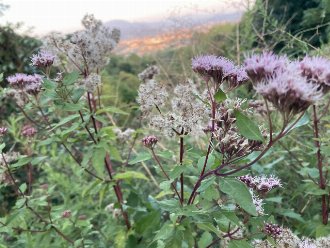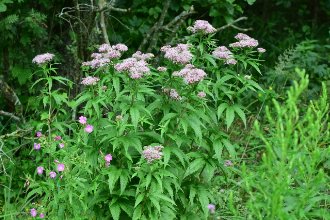Hemp Agrimony (Eupatorium cannabinum L.)
↑Summary
The only Eupatorium native to Europe, introduced at a few locations in North America; superficially resembles the Eutrochium genus, to which it is less closely related.
↑Range - Expand
| Legend | Color |
| Introduced or Not Present | |
| Introduced |
This tentative map is based on our own research. It may have limited data on Canada and/or Mexico, and there is some subjectivity in our assignment of plants as introduced vs. expanded. Read more in this blog post.
Although this plant occurs somewhere in each of these regions, it may only occur in a small part of some or all of them.
This species has also been introduced in British Columbia, Canada; we have not yet built the portion of its range map in Canada.
↑Habitat
This species' habitat preferences in North America are not well known. It likely has some invasive potential and is not more widely established largely because it is not widely planted. It has become more invasive in South Asia near the foothills of the Himalayas, and also in East Asia.
In its native range, it is found in wetlands, including marshes, fens, and swamps, and along streambanks, in moist woods, and at cliff bases. It has a preference for higher pH wetlands with higher mineral content, a trait it shares in common with spotted joe pye weed (Eutrochium maculatum), and it also prefers habitats with a high nitrogen content.
↑Life Cycle
This species is a perennial. The flowers are self-fertile, but can also be pollinated by a variety of insects. Seeds are dispersed by wind.
↑Uses
This species is occasionally used as a landscaping plant. Because it has invasive potential, we strongly recommend not planting it anywhere outside its native range. A visually-similar substitute include the five native Eutrochium species, called Joe-Pye weeds.
↑Related Plants
This species is most closely related to the Eupatorium species native to China, including Eupatorium chinense, and various other species, none of which are found in North America.
It is less closely related to the Eupatorium species native to North America, however, it is probably more closely related to most of them than it is to dogfennel (Eupatorium capillifolium).
↑Notes
This is the only Eupatorium species that has been introduced to North America; thankfully it has not yet become invasive.
↑Links & External Resources
• Eupatorium cannabinum (hemp agrimony) | USDA PLANTS Database (About This Site)
• Hemp Agrimony | iNaturalist (About This Site)
• Eupatorium cannabinum | Biota of North America Project (BONAP) (About This Site)
• Eupatorium cannabinum L. | Plants of the World Online (POWO) (About This Site)
• Eupatorium cannabinum | NatureServe Explorer (About This Site)
• Eupatorium cannabinum | Flora of North America (About This Site)
• Hemp-agrimony | Maryland Biodiversity Project (About This Site)
• Eupatorium cannabinum L. (Hemp-agrimony) | Digital Atlas of the Virginia Flora (About This Site)






